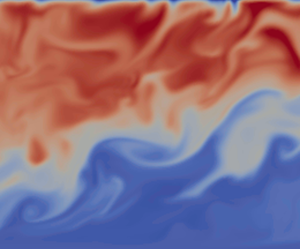Article contents
Destratification of thermally stratified turbulent open-channel flow by surface cooling
Published online by Cambridge University Press: 28 July 2020
Abstract

Destratification of thermally stratified open-channel flow by surface cooling is investigated using direct numerical simulation. The initial states are the equilibrium states resulting from radiative heating. Using these states as initial conditions, a series of direct numerical simulations was run with radiative heating removed and a constant, uniform cooling flux applied at the upper surface. The flow evolves until the initial stable stratification is broken down and replaced by unstable stratification driven by surface cooling. The destratification process is described with reference to the evolution of the internal structure of the turbulent flow field. Based on these observations, we conclude that the dominant time scales in the flow from the perspective of destratification are the time scales associated with shear  ${t}_{\tau }$, convection
${t}_{\tau }$, convection  ${t}_*$ and stable density stratification
${t}_*$ and stable density stratification  ${t}_N$. Scaling arguments are then used to derive a scaling relationship for destratification rate as a function of a friction Richardson number
${t}_N$. Scaling arguments are then used to derive a scaling relationship for destratification rate as a function of a friction Richardson number  $Ri_{\tau } = ( {t}_{\tau }/ {t}_N)^2$ and a convection Richardson number
$Ri_{\tau } = ( {t}_{\tau }/ {t}_N)^2$ and a convection Richardson number  $Ri_* = ( {t}_*/ {t}_N)^2$. The relationship takes the form
$Ri_* = ( {t}_*/ {t}_N)^2$. The relationship takes the form  ${\mathcal {D}}_N = C_1Ri_{\tau }^{-1} + C_2Ri_*^{-1}$, where
${\mathcal {D}}_N = C_1Ri_{\tau }^{-1} + C_2Ri_*^{-1}$, where  ${\mathcal {D}}_N$ is the destratification rate non-dimensionalised with respect to
${\mathcal {D}}_N$ is the destratification rate non-dimensionalised with respect to  $ {t}_N$ and
$ {t}_N$ and  $C_1$ and
$C_1$ and  $C_2$ are model coefficients. The relationship is compared with simulation results and is shown to accurately predict the destratification rate in the simulations across a range of parameters. This relationship is then integrated to give a formula for the time taken for the flow to destratify.
$C_2$ are model coefficients. The relationship is compared with simulation results and is shown to accurately predict the destratification rate in the simulations across a range of parameters. This relationship is then integrated to give a formula for the time taken for the flow to destratify.
Information
- Type
- JFM Papers
- Information
- Copyright
- © The Author(s), 2020. Published by Cambridge University Press
References
REFERENCES
Kirkpatrick et al. supplementary movie 2
Evolution of temperature and vorticity fields for time, t = 1 to 2. Top panel temperature. Bottom panel vorticity. Temperature range: -18 to 45. Vorticity range: 0 to 300.
Kirkpatrick et al. supplementary movie 3
Evolution of temperature and vorticity fields for time, t = 2 to 3. Top panel temperature. Bottom panel vorticity. Temperature range: -15 to 20. Vorticity range: 0 to 300.
- 13
- Cited by

